《药理学》课程教学大纲 Teaching Outline for Pharmacological Course(英文)
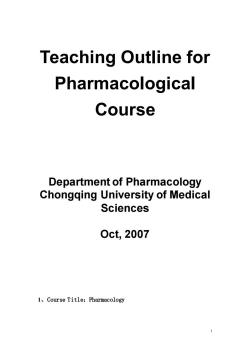
Teaching Outline for Pharmacological Course Department of Pharmacology Chongqing University of Medical Sciences 0ct,2007 1,Course Title:Pharmacology
1 Teaching Outline for Pharmacological Course Department of Pharmacology Chongqing University of Medical Sciences Oct, 2007 1、Course Title:Pharmacology
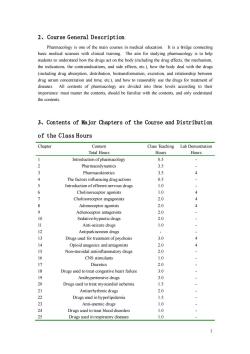
2.Course General Description Pharmacology is one of the main courses in medical education.It is a bridge connecting basic medical sciences with clinical training The aim for studying pharmacology is to help students to understand how the drugs act on the body(including the drug effects,the mechanism. the indications.the contraindications.and side effects.etc how the body deal with the drugs drug serum concentration and time ete),and how to reasonably use the drugs for treatment o diseases.All contents of pharmacology are divided into three levels according to their importance:must master the contents,should be familiar with the contents,and only understand the contents. 3,Contents of Major Chapters of the Course and Distribution of the Class Hours Chapter Content Class Teaching Lab Demostration Total Hours Hours Hours Introduction of pharmacology 0.5 Pharmacodynamics 3.5 35 4 The factors influencing drug actions 5 Introduction of efferent nervous drugs 1.0 Cholinoreceptor agonists 1.0 4 Cholinoreceptor angagonists 20 8 Adrenoceptor agonists 9 Adrenoceptor antagonists 1020 4 Sedative-hypnotic drugs 2.0 Anti-seizure drugs 1.0 Antiparkisonism drugs 345 Drugsused for treatment of psychosis 3.0 anagesics and antagonists 2.0 4 Non-steroidal antiinflammatory drugs 6 CNS stimulants 1.0 Diuretics 20 Drugs used to treat congestive heart failure 3.0 Anti 30 Drus o Antiarrhythmic drugs 20 Drugs used in hyperlipidemia 1. Anti-anemic drugs 1.0 DugsusadIotrealbloodisorders Drugs used in respiratory diseases 1.0
2 2、Course General Description Pharmacology is one of the main courses in medical education. It is a bridge connecting basic medical sciences with clinical training. The aim for studying pharmacology is to help students to understand how the drugs act on the body (including the drug effects, the mechanism, the indications, the contraindications, and side effects, etc.), how the body deal with the drugs (including drug absorption, distribution, biotransformation, excretion, and relationship between drug serum concentration and time, etc.), and how to reasonably use the drugs for treatment of diseases. All contents of pharmacology are divided into three levels according to their importance: must master the contents, should be familiar with the contents, and only understand the contents. 3、Contents of Major Chapters of the Course and Distribution of the Class Hours Chapter Content Total Hours Class Teaching Hours Lab Demostration Hours 1 2 3 4 5 6 7 8 9 10 11 12 13 14 15 16 17 18 19 20 21 22 23 24 25 Introduction of pharmacology Pharmacodynamics Pharmacokinetics The factors influencing drug actions Introduction of efferent nervous drugs Cholinoreceptor agonists Cholinoreceptor angagonists Adrenoceptor agonists Adrenoceptor antagonists Sedative-hypnotic drugs Anti-seizure drugs Antiparkisonism drugs Drugs used for treatment of psychosis Opioid anagesics and antagonists Non-steroidal antiinflammatory drugs CNS stimulants Diuretics Drugs used to treat congestive heart failure Antihypertensive drugs Drugs used to treat myocardial ischemia Antiarrhythmic drugs Drugs used in hyperlipidemia Anti-anemic drugs Drugs used to treat blood disorders Drugs used in respiratory diseases 0.5 3.5 3.5 0.5 1.0 1.0 2.0 2.0 2.0 2.0 1.0 - 3.0 2.0 2.0 1.0 2.0 3.0 3.0 1.5 2.0 1.5 1.0 1.0 1.0 - - 4 - - 4 4 4 - - - - 4 4 - - - - - - - - - - -
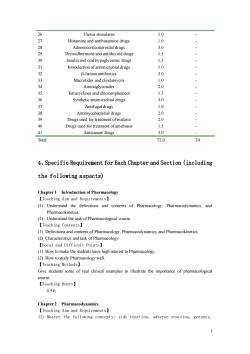
26 Uterus stimulants 10 27 1 Adeenocorticosteroidal drugs 30 Thyroidhormone and antithyroid drugs .5 Insulin and oral hypoglycemic drugs 15 31 Introduction of antimicrobial drugs 1.0 ctam antibiotics 30 3 Macrolides and linda amycin 0 Aminoglycosides Tetracvclines and chloramphenicol 1.5 36 Synthetic antimicrobial drugs 30 Antifugal drugs 10 Antimycobacterial drugs 20 39 Drugs used for treatment of malaria % Drugs used for treatment of amebiasis 1.5 41 Anticancer drugs 3.0 Total 72.0 24 4,Specific Requirement for Each Chapter and Section (including the following aspects) Chapter 1 Introduction of Pharmacology 【Teaching Aim and Requirements】 (1)Understand the definitions and contents of Pharmacology.Pharmacodynamics,and netics (2)Understand the task of Pharmacological course 【Teaching Contents】 (1)Definitions and contents of Pharmacology,Pharmacodynamics,and Pharmacokinetics. ()Characteristics and task of Pharmacology 【Focal and Difficult Points】 (1)How to make the students have high interest to Pharmacology (2)How to study Pharmacology well. 【Teaching Methods】 Give students some of real clinical examples to illustrate the importance of phammacological course 【Teaching Hours】 0.5h Chapter2 Pharmacodynamics 【Teaching Aim and Requirements】 (1)Master the follo ing concepts:side reaction, adverse reaction, potency
3 26 27 28 29 30 31 32 33 34 35 36 37 38 39 40 41 Uterus stimulants Histamine and antihistamine drugs Adeenocorticosteroidal drugs Thyroidhormone and antithyroid drugs Insulin and oral hypoglycemic drugs Introduction of antimicrobial drugs -lactam antibiotics Macrolides and clindamycin Aminoglycosides Tetracyclines and chloramphenicol Synthetic antimicrobial drugs Antifugal drugs Antimycobacterial drugs Drugs used for treatment of malaria Drugs used for treatment of amebiasis Anticancer drugs 1.0 1.0 3.0 1.5 1.5 1.0 3.0 1.0 2.0 1.5 3.0 1.0 2.0 2.0 1.5 3.0 - - - - - - - - - - - - - - - - Total 72.0 24 4、Specific Requirement for Each Chapter and Section (including the following aspects) Chapter 1 Introduction of Pharmacology 【Teaching Aim and Requirements】 (1) Understand the definitions and contents of Pharmacology, Pharmacodynamics, and Pharmacokinetics. (2) Understand the task of Pharmacological course. 【Teaching Contents】 (1) Definitions and contents of Pharmacology, Pharmacodynamics, and Pharmacokinetics. (2) Characteristics and task of Pharmacology 【Focal and Difficult Points】 (1) How to make the students have high interest to Pharmacology. (2) How to study Pharmacology well. 【Teaching Methods】 Give students some of real clinical examples to illustrate the importance of pharmacological course. 【Teaching Hours】 0.5 h. Chapter 2 Pharmacodynamics 【Teaching Aim and Requirements】 (1) Master the following concepts: side reaction, adverse reaction, potency
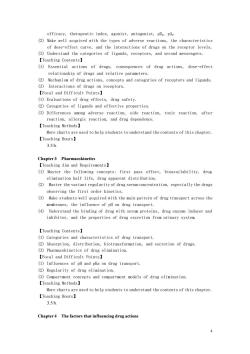
efficacy.therapeutic index.agonist.antagonist.pD.DA. (2)Make well acquired with the types of adverse reactions,the characteristics of dose-effect curve,and the interactions of drugs on the receptor levels. (3)Understand the categories of ligands,receptors,and second messengers. 【Teaching Contents】 (1)Essential actions of drugs.consequences of drug actions.dose-effect relationship of drugs and relative parameters (2)Mechanism of drug actions,concepts and categories of receptors and ligands. (3)Interactions of drugs on receptors. 【Focal and Difficult Points】 (1)Evaluations of drug effects,drug safety. (2)Categories of ligands and effective properties. (3)Differences among adverse reaction,side reaction,toxic reaction,after reaction,allergic reaction,and drug dependence. 【Teaching Methods】 More charts are used to help students to understand the contents of this chapter. 【Teaching Hours】 35h Chapter3 Pharmacokinetics 【Teaching Aim and Requirements】 (1)Master the following concepts:first pass effect,bioavailability,drug ent distribution. observing the first order kinetics (3)Make students well acquired with the main pattern of drug transport across the membranes,the influence of pH on drug transport. (4)Inderstand the binding of drug with serum proteins,drug e inducer and inhibitor, and the e properties of drug excre from urinary systen 【Teaching Contents】 (1)Categories and characteristics of drug transport. (2)Absorption,distribution,biotransformation,and excretion of drugs. ng elimination 【Focal and Difficult Points】 (1)Influences of pH and pKa on drug transport. (2)Regularity of drug elimination. (3)Compartment concepts and compartment models of drug elimination. 【Teaching Methods】 e charts a e used to help students to understand the contents of this chapter 【Teaching Hours】 3.5h Chapter4 The factors that influencing drug actions
4 efficacy, therapeutic index, agonist, antagonist, pD2, pA2. (2) Make well acquired with the types of adverse reactions, the characteristics of dose-effect curve, and the interactions of drugs on the receptor levels. (3) Understand the categories of ligands, receptors, and second messengers. 【Teaching Contents】 (1) Essential actions of drugs, consequences of drug actions, dose-effect relationship of drugs and relative parameters. (2) Mechanism of drug actions, concepts and categories of receptors and ligands. (3) Interactions of drugs on receptors. 【Focal and Difficult Points】 (1) Evaluations of drug effects, drug safety. (2) Categories of ligands and effective properties. (3) Differences among adverse reaction, side reaction, toxic reaction, after reaction, allergic reaction, and drug dependence. 【Teaching Methods】 More charts are used to help students to understand the contents of this chapter. 【Teaching Hours】 3.5 h. Chapter 3 Pharmacokinetics 【Teaching Aim and Requirements】 (1) Master the following concepts: first pass effect, bioavailability, drug elimination half life, drug apparent distribution. (2) Master the variant regularity of drug serum concentration, especially the drugs observing the first order kinetics. (3) Make students well acquired with the main pattern of drug transport across the membranes, the influence of pH on drug transport. (4) Understand the binding of drug with serum proteins, drug enzyme inducer and inhibitor, and the properties of drug excretion from urinary system. 【Teaching Contents】 (1) Categories and characteristics of drug transport. (2) Absorption, distribution, biotransformation, and excretion of drugs. (3) Pharmacokinetics of drug elimination. 【Focal and Difficult Points】 (1) Influences of pH and pKa on drug transport. (2) Regularity of drug elimination. (3) Compartment concepts and compartment models of drug elimination. 【Teaching Methods】 More charts are used to help students to understand the contents of this chapter. 【Teaching Hours】 3.5 h. Chapter 4 The factors that influencing drug actions
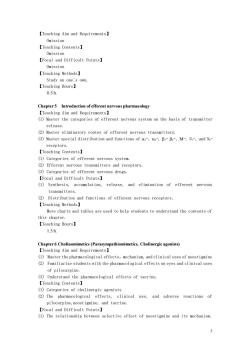
【Teaching Aim and Requirements】 Omission 【Teaching Contents】 Omission 【Focal and Difficult Points】 Omission 【Teaching Methods】 Study one 【Teaching Hours】 0.5h Chapter5 Introduction of efferent nervous pharmacology 【Teaching Ai and Requirements】 (1)Master the categories of efferent nervous system on the basis of transmitter release (2)Master eliminatory routes of efferent nervous transmitters. (3)Master special distribution and functions of a-,a-,B-B:-,M-,N-,and N- receptors 【Teaching Contents】 (1)Categories of efferent nervous system. (2)Efferent nervous transmitters and receptors. (3)Categories of efferent nervous drugs. 【Focal and Difficult Points】 ()Synthesis, accumulation, release,and elimination of efferent nervous transmitters (2)Distribution and functions of efferent nervous receptors. 【Teaching Methods】 More charts and tables are used to help students to understand the contents of this chanter 【Teaching Hours】 1.5h. Chapter6 Cholinomimetics(Parasympathiomimetics,Cholinergic agonists) 【Teaching Aim and Requirements】 (1)Master the pharmacological effects,mechanism,and clinical uses of neostigmine (2)Familiarize students with the pharmacological effects on eyes and clinical uses of pilocarpine. (3)Understand the pharmacological effects of tacrine. 【Teaching Contents】 (1)Categories of cholinergic agonists (2)The pharmacological effects,clinical use,and adverse reactions of pilocarpine,neostigmine,and tacrine. 【Focal and Difficult Points】. (1)The relationship between selective effect of neostigmine and its mechanism. 5
5 【Teaching Aim and Requirements】 Omission 【Teaching Contents】 Omission 【Focal and Difficult Points】 Omission 【Teaching Methods】 Study on one`s own. 【Teaching Hours】 0.5 h. Chapter 5 Introduction of efferent nervous pharmacology 【Teaching Aim and Requirements】 (1) Master the categories of efferent nervous system on the basis of transmitter release. (2) Master eliminatory routes of efferent nervous transmitters. (3) Master special distribution and functions of 1-, 2-, 1- 2-, -, N1-, and N2- receptors. 【Teaching Contents】 (1) Categories of efferent nervous system. (2) Efferent nervous transmitters and receptors. (3) Categories of efferent nervous drugs. 【Focal and Difficult Points】 (1) Synthesis, accumulation, release, and elimination of efferent nervous transmitters. (2) Distribution and functions of efferent nervous receptors. 【Teaching Methods】 More charts and tables are used to help students to understand the contents of this chapter. 【Teaching Hours】 1.5 h. Chapter 6 Cholinomimetics (Parasympathiomimetics, Cholinergic agonists) 【Teaching Aim and Requirements】 (1) Master the pharmacological effects,mechanism, and clinical uses of neostigmine (2) Familiarize students with the pharmacological effects on eyes and clinical uses of pilocarpine. (3) Understand the pharmacological effects of tacrine. 【Teaching Contents】 (1) Categories of cholinergic agonists (2) The pharmacological effects, clinical use, and adverse reactions of pilocarpine,neostigmine, and tacrine. 【Focal and Difficult Points】 (1) The relationship between selective effect of neostigmine and its mechanism
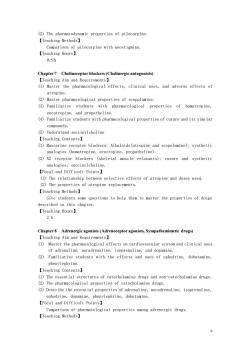
(2)The pharmacodynamic properties of pilocarpine 【Teaching Methods】 Comparison of pilocarpine with neostigmine 【Teaching Hours】 0.5h Chapter7 Cholineceptor blockers(Cholinergicantagonists) 【Teaching Aim and Requirements】 (1)Master the pharmacological effects,clinical uses,and adverse effects of atropine. (2)Master pharmacological properties of scopolamine. (3)Familiarize students with pharmacological properties of homatropine, eucatropine,and propatheline. (4)Familiarize students with pharmacological properties of curare and its similar compounds. (5)Understand succinylcholine 【Teaching Contents】 (1)Muscarine analogies (hor tropine, (2)N2 receptor blockers (skeletal muscle relaxants):curare and synthetic analogies:succinylcholine. 【Focal and Difficult Points】 (1)The relationship between selective effects of atropine and doses used. (2)The properties of atropine replacements. 【Teaching Methods】 Give students some questions to help them to master the properties of drugs described in this chapter. 【Teaching Hours】 2 h Chapter8 Adrenergic agonists(Adrenoceptor agonists,Sympathemimetic drugs) 【Teaching Aim and Requirements】 (1)Master the pharmacological effects on cardiovascular system and clinical uses of adrenaline. noradrenaline renaline. and dopam (students ith the effects and uses of ephedrine,dobutaine. phenylephrine. 【Teaching Contents】 (1)The essential structures of catecholamine drugs and non-catecholamine drugs (2)The pharmacological properties of catecholamine drugs (3)Describe the ess noradrenaline,isoprenaline ephedrine,dopamine,phenylephrine,dobutamine 【Focal and Difficult Points】 Comparison of pharmacological properties among adrenergic drugs 【Teaching Methods】
6 (2) The pharmacodynamic properties of pilocarpine. 【Teaching Methods】 Comparison of pilocarpine with neostigmine. 【Teaching Hours】 0.5 h Chapter 7 Cholineceptor blockers (Cholinergic antagonists) 【Teaching Aim and Requirements】 (1) Master the pharmacological effects, clinical uses, and adverse effects of atropine. (2) Master pharmacological properties of scopolamine. (3) Familiarize students with pharmacological properties of homatropine, eucatropine, and propatheline. (4) Familiarize students with pharmacological properties of curare and its similar compounds. (5) Understand succinylcholine 【Teaching Contents】 (1) Muscarine receptor blockers: Alkaloids(atropine and scopolamine); synthetic analogies (homatropine, ecatropine, propatheline). (2) N2 receptor blockers (skeletal muscle relaxants): curare and synthetic analogies; succinylcholine. 【Focal and Difficult Points】 (1) The relationship between selective effects of atropine and doses used. (2) The properties of atropine replacements. 【Teaching Methods】 Give students some questions to help them to master the properties of drugs described in this chapter. 【Teaching Hours】 2 h Chapter 8 Adrenergic agonists (Adrenoceptor agonists, Sympathemimetic drugs) 【Teaching Aim and Requirements】 (1) Master the pharmacological effects on cardiovascular system and clinical uses of adrenaline, noradrenaline, isoprenaline, and dopamine. (2) Familiarize students with the effects and uses of ephedrine, dobutamine, phenylephrine. 【Teaching Contents】 (1) The essential structures of catecholamine drugs and non-catecholamine drugs. (2) The pharmacological properties of catecholamine drugs. (3) Describe the essential properties of adrenaline, noradrenaline, isoprenaline, ephedrine, dopamine, phenylephrine, dobutamine. 【Focal and Difficult Points】 Comparison of pharmacological properties among adrenergic drugs. 【Teaching Methods】
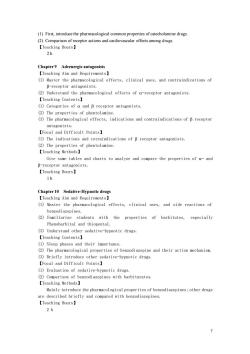
(1)First.introduce the pharmacological common properties of catecholamine drugs (2)Comparison of and cardiovascular effectsamong drugs Chapter9 Adrenergic antagonists ets.elinical usand cotrain (1)Master the B-receptor antagonists. (2)Understand the pharmacological effects of a-receptor antagonists. 【Teaching Contents】 (1)Categories of a and B receptor antagonists. (2)The roperties of phentolam (3)The pharmacological effects,indications and contraindications of B receptor antagonists 【Focal and Difficult Points】 (1)The indications and cotraindications of B receptor antagonists. (2)The properties of phentolamine 【Teaching Methods】 Give some tables and charts to analyze and compare the properties of a-and B-receptor antagonists. 【Teaching Hours】 Ih Chapter 10 Sedative-Hypnotic drugs 【Teaching Aim and Requirements】 (1)Master the pharmacological effects,clinical uses,and side reactions of benzodiazepines」 (2)Familiarize students with the properties of barbitutes, especially Phenobarbital and thiopental (3)Understand other sedative-hypnotic drugs. 【Teaching Contents】 (1)Sleep phases and their importance. (2)The pharmacological properties of benzodiazepine and their action mechanism (3)Briefly intre duce c sedative-hypnotic drugs 【Focal and Difficult Points】 (1)Evaluation of sedative-hypnotic drugs. (2)Comparison of benzodiazepines with barbiturates. 【Teaching Methods】 Mainlyintroduce the pharmacological proper rties of benzodiazepines:other drugs are described briefly and compared with benzodiazepines Teaching Hours】 2 h
7 (1) First, introduce the pharmacological common properties of catecholamine drugs. (2) Comparison of receptor actions and cardiovascular effects among drugs. 【Teaching Hours】 2 h Chapter 9 Adrenergic antagonists 【Teaching Aim and Requirements】 (1) Master the pharmacological effects, clinical uses, and contraindications of -receptor antagonists. (2) Understand the pharmacological effects of -receptor antagonists. 【Teaching Contents】 (1) Categories of and receptor antagonists. (2) The properties of phentolamine. (3) The pharmacological effects, indications and contraindications of receptor antagonists. 【Focal and Difficult Points】 (1) The indications and cotraindications of receptor antagonists. (2) The properties of phentolamine. 【Teaching Methods】 Give some tables and charts to analyze and compare the properties of - and -receptor antagonists. 【Teaching Hours】 1 h Chapter 10 Sedative-Hypnotic drugs 【Teaching Aim and Requirements】 (1) Master the pharmacological effects, clinical uses, and side reactions of benzodiazepines. (2) Familiarize students with the properties of barbitutes, especially Phenobarbital and thiopental. (3) Understand other sedative-hypnotic drugs. 【Teaching Contents】 (1) Sleep phases and their importance. (2) The pharmacological properties of benzodiazepine and their action mechanism. (3) Briefly introduce other sedative-hypnotic drugs. 【Focal and Difficult Points】 (1) Evaluation of sedative-hypnotic drugs. (2) Comparison of benzodiazepines with barbiturates. 【Teaching Methods】 Mainly introduce the pharmacological properties of benzodiazepines; other drugs are described briefly and compared with benzodiazepines. 【Teaching Hours】 2 h
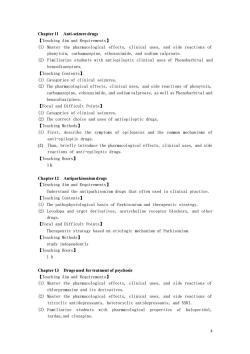
Chapter 11 Anti-seizure drugs 【Teaching Aim and Requirements】 (1)Master the pharmacological effects,clinical uses,and side reactions of phenytoin,carbamazepine,ethosuximide,and sodium valproate. (2)Fimiliarize students with antiepileptic clinical uses of Phenobarbital and benzodiazepines. 【Teaching Contents】 (1)Categories of clinical seizures (2)The pharmacological effects,clinical uses,and side reactions of phenytoin, carbamazepine,ethosuximide,and sodium valproate,as well as Phenobarbital and henzodiazinines. 【Focal and Difficult Points】 (1)Categories of clical (2)The correct choice and uses of antiepileptic drugs. [Teaching Methods】 (1)First,describe the symptoms of epilepsies and the common mechanisms of anti-epileptic drugs. (2)Than,briefly introduce the pharmacological effects,clinical uses,and side reactions of anti-epileptic drugs 【Teaching Hours】 Ih and Requirements】 Understand the antiparkisonism drugs that often used in clinical practice. 【Teaching Contents】 (1)The pathophysiological basis of Parkisonism and therapeutic strategy. (2)Levodopa and ergot derivatives, acetycholine receptor blockers, and other drugs 【Focal and Difficult Points】 Therapeutic strategy based on etiologic mechanism of Parkisonism. 【Teaching Methods】 study independently 【Teaching Hou s】 1h Chapter 13 Drugs used for tratment of psychosis 【Teaching Aim and Requirements】 (1)Master the pharmacological effects,clinical uses,and side reactions of chlorpro azine and its derivatives (2)Master the pharmacological effects,clinical uses,and side reactions of tricyclic antidepressants,heterocyclic antidepressants,and SSRI. (3)Familiarize students with pharmacological properties of haloperidol, tardan,and clozapine
8 Chapter 11 Anti-seizure drugs 【Teaching Aim and Requirements】 (1) Master the pharmacological effects, clinical uses, and side reactions of phenytoin, carbamazepine, ethosuximide, and sodium valproate. (2) Fimiliarize students with antiepileptic clinical uses of Phenobarbital and benzodiazepines. 【Teaching Contents】 (1) Categories of clinical seizures. (2) The pharmacological effects, clinical uses, and side reactions of phenytoin, carbamazepine, ethosuximide, and sodium valproate, as well as Phenobarbital and benzodiazipines. 【Focal and Difficult Points】 (1) Categories of clinical seizures. (2) The correct choice and uses of antiepileptic drugs. 【Teaching Methods】 (1) First, describe the symptoms of epilepsies and the common mechanisms of anti-epileptic drugs. (2) Than, briefly introduce the pharmacological effects, clinical uses, and side reactions of anti-epileptic drugs. 【Teaching Hours】 1 h Chapter 12 Antiparkisonism drugs 【Teaching Aim and Requirements】 Understand the antiparkisonism drugs that often used in clinical practice. 【Teaching Contents】 (1) The pathophysiological basis of Parkisonism and therapeutic strategy. (2) Levodopa and ergot derivatives, acetycholine receptor blockers, and other drugs. 【Focal and Difficult Points】 Therapeutic strategy based on etiologic mechanism of Parkisonism. 【Teaching Methods】 study independently 【Teaching Hours】 1 h Chapter 13 Drugs used for tratment of psychosis 【Teaching Aim and Requirements】 (1) Master the pharmacological effects, clinical uses, and side reactions of chlorpromazine and its derivatives. (2) Master the pharmacological effects, clinical uses, and side reactions of tricyclic antidepressants, heterocyclic antidepressants, and SSRI. (3) Familiarize students with pharmacological properties of haloperidol, tardan,and clozapine
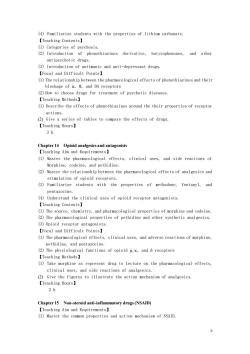
(4)Familiarize students with the properties of lithium carbonate. 【Teaching Contents】 of phenothiazines derivative,butyrophenones,and other antipsychotic drugs. (3)Introduction of antimanic and anti-depressant drugs. 【Focal and Difficult Points】? blockage of a,M,and DA receptors (2)How to choose drugs for treatment of psychotic diseases. 【Teaching Methods】 (1)Describe the effects of phenothiazines around the their properties of receptor actions. (2)Give a series of tables to compare the effects of drugs 【Teaching Hours】 3 h Chapter 14 Opioid analgesics and antagonists 【T ching Ain and Requirements】 (1)Master the pharmacological effects,clinical uses,and side reactions of Morphine,codeine.and pethidine. (2)Master the relationship between the pharmacological effects of analgesics and stimulation of opioid receptors. (3)Familiarize dents with the properties of methadone,fentanyl,and pentazocine (4)Understand the clinical uses of opioid receptor antagonists. 【Teaching Contents】 (1)The source.chemistry.and pharmacological properties of morphine and codeine. (2)The pharmacological properties of pethidine and other synthetic analgesics. (3)Opioid receptor 【Focal and Difficult Points】. (1)The pharmacological effects,clinical uses,and adverse reactions of morphine. pethidine,and pentazocine. (2)The physiological functions of opioid and receptors 【Teaching Methods】 (1)Take morphine as represent drug to lecture on the pharmacological effects, clinical uses.and side reactions of analgesics. (2)Give the figures to illustrate the action mechanism of analgesics. 【Teaching Hours】 2h Chapter 15 Non-steroid anti-inflammatory drugs(NSAID) 【Teaching Aim and Requirements】 (1)Master the common properties and action mechanism of NSAID
9 (4) Familiarize students with the properties of lithium carbonate. 【Teaching Contents】 (1) Categories of psychosis. (2) Introduction of phenothiazines derivative, butyrophenones, and other antipsychotic drugs. (3) Introduction of antimanic and anti-depressant drugs. 【Focal and Difficult Points】 (1) The relationship between the pharmacological effects of phenothiazines and their blockage of , M, and DA receptors (2) How to choose drugs for treatment of psychotic diseases. 【Teaching Methods】 (1) Describe the effects of phenothiazines around the their properties of receptor actions. (2) Give a series of tables to compare the effects of drugs. 【Teaching Hours】 3 h Chapter 14 Opioid analgesics and antagonists 【Teaching Aim and Requirements】 (1) Master the pharmacological effects, clinical uses, and side reactions of Morphine, codeine, and pethidine. (2) Master the relationship between the pharmacological effects of analgesics and stimulation of opioid receptors. (3) Familiarize students with the properties of methadone, fentanyl, and pentazocine. (4) Understand the clinical uses of opioid receptor antagonists. 【Teaching Contents】 (1) The source, chemistry, and pharmacological properties of morphine and codeine. (2) The pharmacological properties of pethidine and other synthetic analgesics. (3) Opioid receptor antagonists. 【Focal and Difficult Points】 (1) The pharmacological effects, clinical uses, and adverse reactions of morphine, pethidine, and pentazocine. (2) The physiological functions of opioid µ, , and receptors 【Teaching Methods】 (1) Take morphine as represent drug to lecture on the pharmacological effects, clinical uses, and side reactions of analgesics. (2) Give the figures to illustrate the action mechanism of analgesics. 【Teaching Hours】 2 h Chapter 15 Non-steroid anti-inflammatory drugs (NSAID) 【Teaching Aim and Requirements】 (1) Master the common properties and action mechanism of NSAID
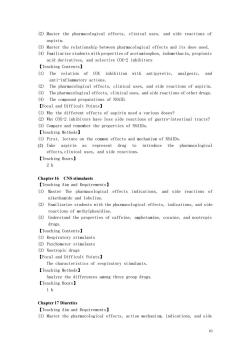
(2)Master the pharmacological effects.clinical uses.and side reactions of aspirin. (3)Master the relationship between pharmacological effects and its dose used. (4)Familiarize students with properties of acetaminophen,indomethacin,propionic acid derivatives,and selective COX-2 inhibitors 【Teaching Contents】 (1)The relation of CoX inhibition with antipyretic, analgesic,and anti-inflammatory actions (2)The pharmacological effects,clinical uses,and side reactions of aspirin. (3)The pharmacological effects,clinical uses,and side reactions of other drugs. (4)The compound preparations of NSAID. 【Focal and Difficult Points】 (1)hy the diff erent effects of aspirin need a various doses (2)Why CoX-2 inhibitors have less side reactions of gastro-intestinal tracts? (3)Compare and remember the properties of NSAIDs. 【Teaching Methods】 (1)First.lecture on the common effects and mechanism of NSAIDs (2)Take aspirin rep drug to introduce the pharmacological effects,clinical uses,and side reactions. 【Teaching Hours】 2h (1)Master The pharmacological effects indications,and side reactions of nikethamide and lobeline. (2)Familiarize students with the pharmacological effects,indications,and side reactions of methylphenidine (3)Understand the proper ties of caffeine,amphetamine,cocaine,and nootropic drugs 【Teaching Contents】 (1)Respiratory stimulants (2)Psychomoter stimulants (3)Nootronic drugs 【Focal and Difficult Points】 The characteristics of respiratory stimulants. 【Teaching Methods】 Analyze the differences among three group drugs 【Teaching Hours】 1h Chapter 17 Diuretics 【Teaching Aim and Requirements】 (1)Master the pharmacological effects,action mechanism,indications,and side
10 (2) Master the pharmacological effects, clinical uses, and side reactions of aspirin. (3) Master the relationship between pharmacological effects and its dose used. (4) Familiarize students with properties of acetaminophen, indomethacin, propionic acid derivatives, and selective COX-2 inhibitors 【Teaching Contents】 (1) The relation of COX inhibition with antipyretic, analgesic, and anti-inflammatory actions. (2) The pharmacological effects, clinical uses, and side reactions of aspirin. (3) The pharmacological effects, clinical uses, and side reactions of other drugs. (4) The compound preparations of NSAID. 【Focal and Difficult Points】 (1) Why the different effects of aspirin need a various doses? (2) Why COX-2 inhibitors have less side reactions of gastro-intestinal tracts? (3) Compare and remember the properties of NSAIDs. 【Teaching Methods】 (1) First, lecture on the common effects and mechanism of NSAIDs. (2) Take aspirin as represent drug to introduce the pharmacological effects,clinical uses, and side reactions. 【Teaching Hours】 2 h Chapter 16 CNS stimulants 【Teaching Aim and Requirements】 (1) Master The pharmacological effects indications, and side reactions of nikethamide and lobeline. (2) Familiarize students with the pharmacological effects, indications, and side reactions of methylphenidine. (3) Understand the properties of caffeine, amphetamine, cocaine, and nootropic drugs. 【Teaching Contents】 (1) Respiratory stimulants (2) Psychomoter stimulants (3) Nootropic drugs 【Focal and Difficult Points】 The characteristics of respiratory stimulants. 【Teaching Methods】 Analyze the differences among three group drugs. 【Teaching Hours】 1 h Chapter 17 Diuretics 【Teaching Aim and Requirements】 (1) Master the pharmacological effects, action mechanism, indications, and side
按次数下载不扣除下载券;
注册用户24小时内重复下载只扣除一次;
顺序:VIP每日次数-->可用次数-->下载券;
- 《药理学》课程教学课件(PPT讲稿)Section 1 Basic Principles of Pharmacology.ppt
- 《药理学》课程教学课件(PPT讲稿)β-Lactam antibiotics.ppt
- 《药理学》课程教学资源(教材讲义,英文版)药理学教材讲义(Chapter 36 -41).doc
- 《药理学》课程教学课件(PPT讲稿)Thyroid and Antithyroid Drug.ppt
- 《药理学》课程教学资源(教材讲义,英文版)药理学教材讲义(共六部分,四十一章).doc
- 《药理学》课程教学实验指导书(共十四个实验).doc
- 《药理学》课程实验指导(讲义)实验7 传出神经系统药物对麻醉兔血压的作用.doc
- 《药理学》课程实验指导(讲义)实验6 传出神经系统药物对蟾蜍腹直肌的作用.doc
- 《药理学》课程实验指导(讲义)实验5 全血水杨酸钠二室模型药动学参数测定.doc
- 《药理学》课程实验指导(讲义)实验4 肝脏功能对药物作用的影响.doc
- 《药理学》课程实验指导(讲义)实验3 不同给药途径对药物作用的影响.doc
- 《药理学》课程实验指导(讲义)实验2 药物的基本作用.doc
- 《药理学》课程实验指导(讲义)实验1 实验动物的捉持法和给药法.doc
- 《药理学》课程授课教案(讲义)麻醉性镇痛药.doc
- 《药理学》课程授课教案(讲义)平喘药.doc
- 《药理学》课程授课教案(讲义)子宫用药.doc
- 《药理学》课程授课教案(讲义)抗甲亢.doc
- 《药理学》课程授课教案(讲义)抗组胺药.doc
- 《药理学》课程授课教案(讲义)抗糖尿病药.doc
- 《药理学》课程授课教案(讲义)抗慢性心功能不全.doc
- 《药理学》课程教学大纲 Teaching Outline for Pharmacological Course(中文).doc
- 《药理学》课程教学资源(试卷习题)examination paper A(含答案).doc
- 《药理学》课程教学资源(试卷习题)examination paper B(含答案).doc
- 《临床药理学》课程教学大纲 clinical pharmacology.doc
- 《临床药理学》课程考试大纲(clinical pharmacology).doc
- 《临床药理学》课程授课教案.doc
- 《临床药理学》课程试题试卷库(无答案).doc
- 《临床药理学》课程作业习题1(无答案).doc
- 《临床药理学》课程作业习题2(无答案).doc
- 《临床药理学》课程教学课件(PPT讲稿)病理讨论2.ppt
- 《临床药理学》课程教学课件(PPT讲稿)第三章 治疗药物监测和给药个体化.ppt
- 《临床药理学》课程教学课件(PPT讲稿)第一章 绪论(石河子大学:胡艳丽).ppt
- 《临床药理学》课程教学课件(PPT讲稿)第二章 临床药代动力学.ppt
- 《临床药理学》课程教学课件(PPT讲稿)第八章 新生儿及儿童用药.ppt
- 《临床药理学》课程教学课件(PPT讲稿)第七章 妊娠期和哺乳期妇女用药.ppt
- 《临床药理学》课程教学课件(PPT讲稿)第九章 老年人用药.ppt
- 《临床药理学》课程教学课件(PPT讲稿)第十三章 药物相互作用.ppt
- 《临床药理学》课程教学课件(PPT讲稿)第十二章 药品不良反应监测与药物警戒.ppt
- 《临床药理学》课程教学课件(PPT讲稿)第十四章 药物滥用和药物依赖性.ppt
- 《临床药理学》课程教学课件(PPT讲稿)病理讨论1.ppt
